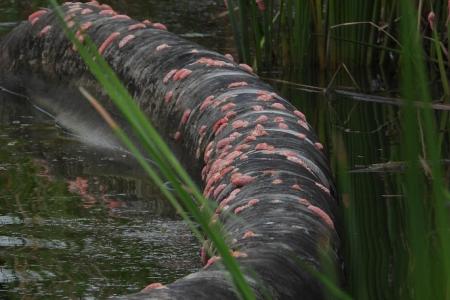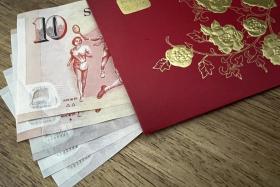Invasive snail eggs spotted in Lower Seletar Reservoir
Amid the rocks, water and greenery at Lower Seletar Reservoir, the blobs of pink stood out.
Not only did they catch the attention of Facebook user Elsa Xu on Oct 5, but they also set off alarm bells for her.
The large clusters belong to an invasive snail species known as the golden apple snail.
In her post on the Nature Society Singapore (NSS) Facebook page on the same day, Ms Xu said she was taking a walk with her daughter along the reservoir when they stumbled across a “significant presence of golden apple snail eggs”.
Expressing her shock, she added: “They are scattered everywhere – along the bank, on the rocks, and even on the reeds. The situation is alarming, and I believe immediate action is needed to address this issue and remove the eggs.”
She added that she has e-mailed national water agency PUB to bring the matter to its attention.
Several photos of the scene captured by Ms Xu show hundreds of bright pink egg clusters speckled across the reservoir’s rocks and vegetation.
In one photo, a plastic bag is seen to be overflowing with snail shells.
According to a biodiversity guide by PUB, the golden apple snail, which has the scientific name pomacea canaliculata, is one of the top 100 most invasive species in the world.
Originally from South America, it arrived in South-east Asia through the aquarium trade and is believed to out-compete native apple snails throughout the region. The golden apple snail lays pink eggs in clusters of between hundreds and up to a thousand, which is one reason why native species of apple snails, which lay eggs only in the hundreds, are being crowded out.
In 2012, the European Union banned all imports of snails belonging to the genus Pomacea because of their destructive impact on agriculture.
The snails’ bright pink eggs are often spotted on plants and structures emerging from the water surface, the PUB guide said.
Commenting on Ms Xu’s post, fellow nature enthusiasts from the NSS Facebook group also expressed concern about the damage these eggs could bring to the local ecosystem.
One user expressed worry about the eggs potentially being toxic to humans and animals, and warned others to be careful around the eggs when they are with young children or pets.
Another user was concerned that the eggs could cause severe damage to Singapore’s plants.
But some users put a more light-hearted spin on the situation.
“So much mentaiko! Perfect for your sashimi and sushi!” one wrote in jest, referring to the spicy cured pollack roe dish that has a pink hue similar to the snail eggs.
“Parasite mentaiko,” another wrote.
Ms Xu’s post has garnered more than 230 likes and 64 comments as of Oct 6, 3.45pm.
This is not the first time the species seems to have taken over Lower Seletar Reservoir - with widespread clusters of the invasive ‘mentaiko’ also spotted in 2021.
In a Facebook post on the situation then, PUB said the non-native freshwater mollusc is mostly found in urbanised freshwater habitats, such as reservoirs and ponds.
It added while that the eggs do not affect the water quality of Singapore’s reservoirs, PUB and the National Parks Board (NParks) regularly remove these eggs as part of their maintenance works in nature areas and reservoirs here.
“We would like to remind everyone that the release of animals into our reservoirs can upset the aquatic ecosystem of our waters. It is important that we are aware of the impact such acts can have on the native biodiversity in our waters,” it said.
Get The New Paper on your phone with the free TNP app. Download from the Apple App Store or Google Play Store now


